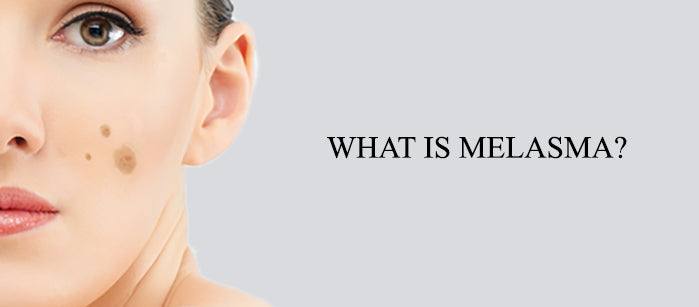What is Melasma

Aging is a normal and natural process. Aging gracefully is very important. Aging can affect your skin in a negative manner. Did you after the age of 30+, need to take extra care of your skin and body? Yes, that is true. Melasma is one of the common skin conditions which results in brown patches and discoloration of the skin. It occurs with age. But, not everyone gets affected by melasma or discoloration. Taking adequate preventative measures for skin as you age can help prevent melasma. This melasma affects the face more prominently.
An overview of Melasma
Let us give you some insights into how melasma occurs and science behind the melasma
What is Melasma?
Melasma is a skin condition that results in spots, blotches, and patches on the skin, especially on the nose, forehead, cheeks, and chin. These patches may be mild, moderate, and large in size. It may affect a part of the face or may involve the entire face. It is chiefly present in sun-exposed areas. It is also simply termed “hyperpigmentation.”
Why does melasma affect the face?
The face is the most exposed part. We generally tend to cover our body with clothing in all seasons throughout the year. While stepping out in the sun or during the daytime, we do not carry any protective shield for our facial skin. Yes, that's true, we generally wear makeup and step out with good looks forgetting about skin damage. Over time, this may cause more damage which can expectedly cause negative effects and lead to melasma or hyperpigmentation.
Is melasma a medical condition?
Well, melasma is not a medical condition and is completely harmless in its initial stages. Untreated or neglected cases of melasma can affect mental health causing social embarrassment. So, it is important to seek treatment at an early stage. The best way is to avoid it completely by taking good skincare and using the right quality products. Also, it is important to avoid melasma at the initial stages as complicated cases may lead to skin cancer.
How do I diagnose melasma at the initial stages to avoid complications?
It may start with freckles, sunspots, or age spots which may go unnoticed initially. This may coalesce to form large blotchy skin and patches. Initially, they may be light brownish in color and may turn blackish or grayish in color.
What are the causes of melasma?
- Hormones
- Pregnancy
- Sun exposure
- Genetics
- Skin inflammation
- Certain drugs and cosmetic products
What are the symptoms of melasma?
- The flat discolored area on the skin
- Darkening of skin
- Reddening of skin
- Slightly itchy skin
- Burning sensation at times
- Uneven skin tone
- Post-inflammatory condition after acne or wound
- Post acne scar or wound scar or burn injury
How does melasma occur?
This is a very important question. Being aware of the causative factor and eliminating it completely is a great idea to avoid melasma.
Melasma develops due to the oversecretion of melanin pigment in certain areas. The skin comprises -
- 5 protective layers which epidermis and dermis ( important layers of the skin)
- Melanocytes( skin cells)
- Melanin ( skin pigment)
The Melanocyte Stimulating Hormone (MSH) stimulated the melanocytes (skin cells) to secrete melanin pigment (skin pigment) which gives color to the skin. When the hormonal balance goes for a toss, there is oversecretion of melanin skin pigment causing brownish discoloration or hyperpigmentation of the skin. Even, the slightest stress or defective metabolism can stimulate the stress hormone (cortisol) and the thyroid hormones respectively. Here, it is important to keep stress at bay and embrace a healthy lifestyle for good skin.
When does melasma occur?
- Melasma often occurs in pregnancy when there are hormonal changes.
- Melasma can occur in the elderly age group due to aging factor
- Melasma can also occur if you have used the wrong quality of makeup. The pigments from the makeup can cause brownish discoloration especially if the makeup ingredients have crossed the expiry date.
- Melasma can also occur if you have any thyroid disorders or PCOD
- Melasma can occur in case you exfoliate your skin and suddenly step into the harsh sun. Make sure to use mild exfoliation at night daily which will allow the skin to repair
- An unhealthy diet can cause melasma especially when eating fried food due to lipid oxidation which leads to discoloration of the skin due to fatty acid deposits.
- Vitamin Deficiency can also cause melasma
- Consuming too much copper water can cause brownish discoloration of the skin.
- Uncontrollable diabetes can lead to brownish discoloration of skin or melasma.
Is there any cure for melasma?
Melasma can be prevented at the initial stage. The chances of recovery are higher if you are of young age and if melasma is detected early. Pregnancy-related melasma can be recovered with lifestyle modifications. However, you can take these precautionary measures to control the spread of melasma-
- Healthy diet
- Reduced stress levels
- Exercising
- Good quality skin care products especially natural products
- Regular use of Vitamin C serum can help
- Plant-based glutathione extract products
- Skincare products rich in antioxidants
- Natural skin whitening and glycolic acid products
- Use sunscreen always during the day
- A regular natural detox of the body and skin can help
So, take care of your skin right from a young age for healthy and graceful aging. Our main aim with this article on melasma is to make you aware of the causes of melasma to prevent melasma before you need treatment for its cure.